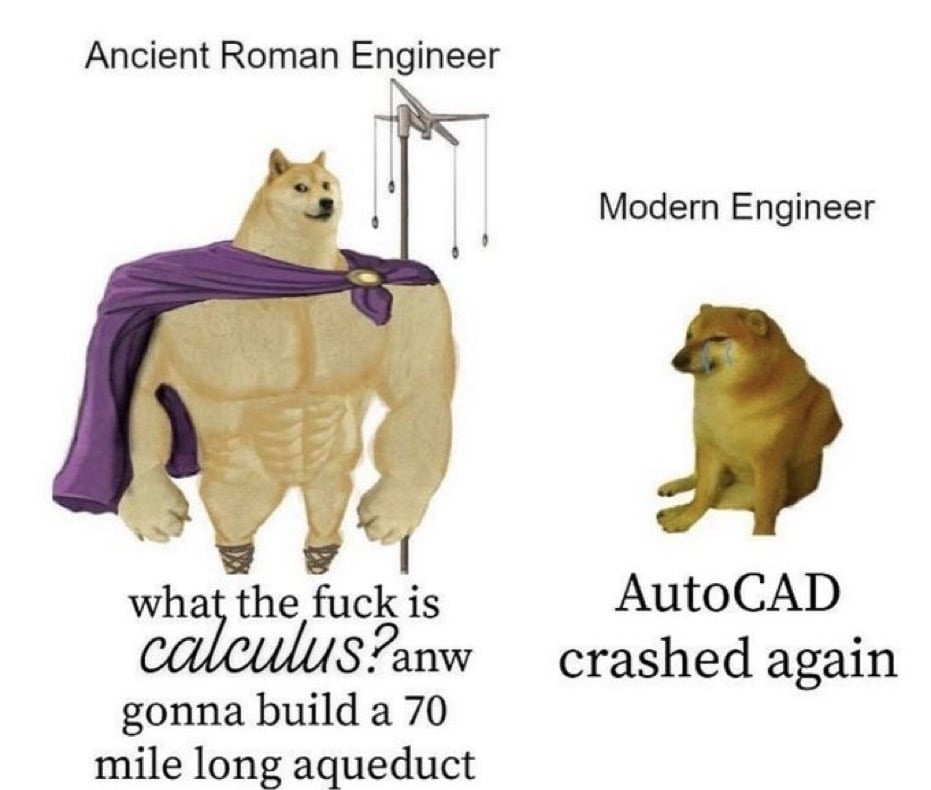this post was submitted on 03 Oct 2024
560 points (96.4% liked)
196
16597 readers
1753 users here now
Be sure to follow the rule before you head out.
Rule: You must post before you leave.
founded 1 year ago
MODERATORS
you are viewing a single comment's thread
view the rest of the comments
view the rest of the comments

Calculus is a specific field of mathematics, mostly to do with limits, integrals and derivatives. Those all feature very heavily in working out loads and stresses.
But it's unfair to say the Roman didn't have calculus. It wasn't formal calculus, but they absolutely had mathematics, and the Greeks worked out the exhaustion method a century before the Via Appia was even started.
You don't need calculus to do some very impressive building, you can go very very far with experience, rules of thumb and basic maths. Hell, ask any civil engineer and they'll gladly show you some common formula that makes physicists cry.
Put simply, you don't need to know of, or what a certain field of math is to be able to apply the different fundamentals of it.
As an example. You ever see a basketball player bring out a chalkboard to calculate the trajectory, mass, spin, or force to throw the ball to get it in the basket? No. Over time they all eventually create a physics model in their heads and are able to subconsciously calculate all of that with relative accuracy based on experience, training, and practice. Yet, a lot of those players never took a lick of physics.
Do you happen to know any civil engineers, I would like to see these formulas
Hi, civil engineer* here. Nah, fam: a lot of the time we don't even use formulas; we just look shit up in tables or interpolate on a graph!
(* To be fair, (a) I specialized in traffic, and (b) I didn't do all that much professional work as a civil engineer before switching to software "engineering" instead. That's even less mathematically rigorous most of the time, LOL.)
One of the famous ones is laminar flow in a tube or pipe. There's a very nice physics formula to compute Reynolds number, and when it's over 3500, flow is usually turbulent, and below 2000 it's usually laminar. And anywhere in between? Eh, it kinda depends. Unless there are bends in the tube, then it depends even more. Oh, and when your flow is not in a tube, the values wildly vary even more.
There's a concept of "angle of repose", basically at what slope will loosely poured materials sit. There are super complex modern models to compute that, based on grain size and shape. But there's also a half-page table listing anything from asphalt to coffee beans, which is literally the law in a lot of countries. That table is older than the age of sail in most cases and zero maths went into it.
And then there is the hilarious official ways to determine the characteristics of concrete and asphalt. The flow test, for example includes the highly scientific steps of "pour into a specific cone and poke 25 times with a two by four, then measure the circle on the floor". This number is then used in several calculations.
π=3
Ohh yeah, I've used that one
You from Indiana too? Lol
Not civil but mechanical engineer here. There are some rule of thumb formulas involved during the construction of a gearbox, e.g. the diameter in
mmof a shaft at the bearings: cubic root of the torque inNm. The 'necessary volume' of a gear wheel is another formula involving adventurous math.when we approximate g to 10 they weep.